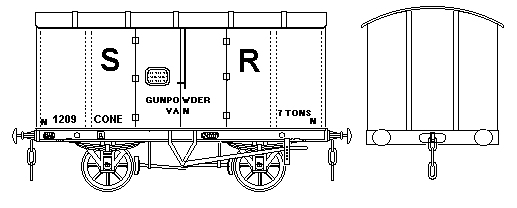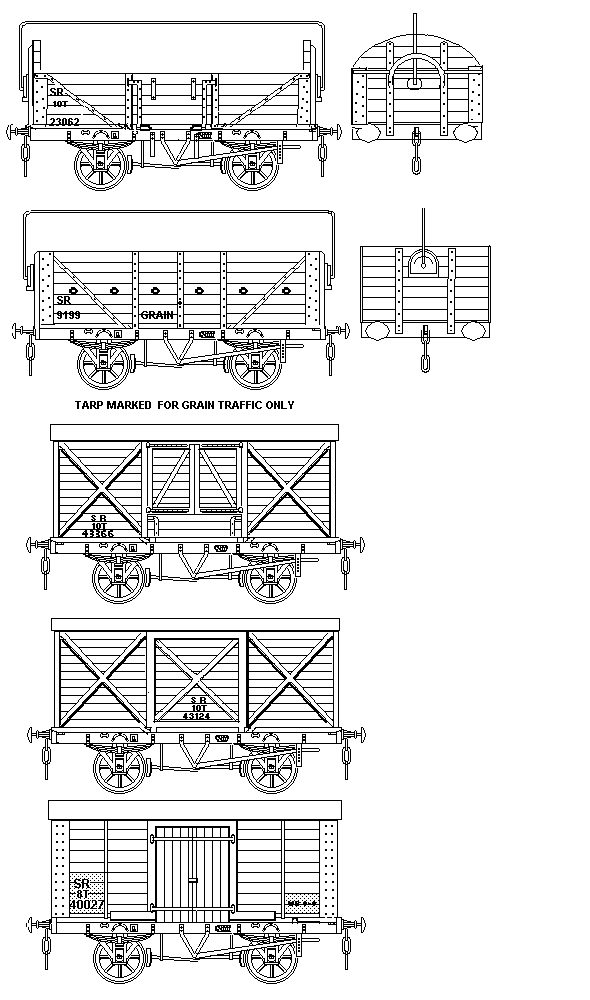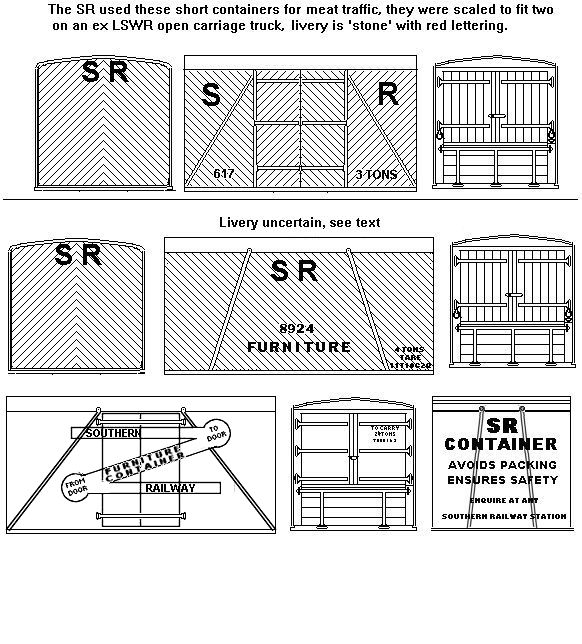
| Return to index page |
Southern Railway
The smallest contributor to the goods scene in terms of numbers although it had a splendidly varied selection of absorbed stock from the 1923 grouping. The Southern was the only railway to receive most of its revenue from passenger traffic, in spite of having several important ports (such as Southampton) and local industries such as cement. At the time of the 1923 grouping the total annual mileage for passenger traffic was some six or seven times that for goods stock.
The basic body colour for goods stock was the old London & South Western Railway standard `goods brown' with white lettering, as seen on the Graham Farish SR wagons & vans. The underframe and running gear being officially black in all cases, however the body colour was often applied to the solebars and even extended over the axle boxes in some cases. Roofs were white or mid grey, again fading and weathering to grey in service.
The standard lettering was S R in white sans serif script about 18 (46 cm) inches high on the sides of wagons and vans with the number of the vehicle in the lower left corner, and the tare weight, in the form 7-1-2 (tons cwt. and quarters), in the lower right corner. The capacity was generally painted above the tare in the form `10 TONS', but seems to have appeared above the running number in some cases. The classic SR open wagon was the 8 plank type with hinged upper doors, this is shown in the original SR livery in the section on Goods Rolling Stock Design - The Body.
One exception to this arrangement was the cattle wagon, these had the large S R on the sides, but the rest appeared on the ends, to the outside of the left vertical brace. The tare on the bottom plank about 3 inches (7.5 cm) high with the word tare about the same height above this, the load (in the form 10 TONS) on the fourth plank up about 5 inches (13 cm) high, the wagon number three planks above that and SR about 5 inches (13 cm) high on the next plank up.
The open grain hopper wagons were painted in standard goods brown but had the word GRAIN painted low down on the centre of the sides where the drop doors would normally have been.
Non common user stock was identified by a 4 inch (10 cm) high letter N in each lower corner of the body sides.
Standard 'iron mink' type gunpowder vans were supplied to the SR by the GWR in the late 1930's, these had the standard GWR colours, with SR in place of GWR in the lower left.
Insulated, Ventilated Meat and Banana vans (as offered by Peco) were painted a light buff, officially referred to as `stone', this being applied to cover the headstocks but not (officially) the solebars which were to be painted dark brown. Lettering on these vehicles was venetian red with the wheels, buffers and remainder of the underframe being black.
Reefer (refrigerated) vans were light buff (stone) with red lettering for ex LSWR stock but white with black lettering for SR built stock. The underframe and running gear being black.
Engineers wagons, (PW, S&T etc.) were marked with a small (perhaps 5 inch high) ED to the upper right of the body.
The lettering size changed to bring it into line with the other companies in 1937 when the standard layout of company initials/load/number to the lower left and XP (if applicable)/ wheel base in the lower right. Hence although the Graham Farish Twin Vent Van is an SR design, which was supplied to other companies in the 40's it is in incorrect livery for all of these. Had Graham Farish used the smaller lettering it would have been correct. The SR adopted the N for non-common user stock as shown in Fig ___ below on the curious part-metal sheet part-wood planked meat van in post 1937 livery of buff with red lettering. Incidentally this wagon was reported as having a light grey roof.
Gunpowder vans were in standard freight livery.
Fig ___ SR Gunpowder van 
Non passenger coaching stock, carriage trucks, prize cattle vans, horse boxes etc., used basic passenger livery. During the Maunsell era this was sides in un-lined green (early examples faded towards Prussian blue in service due to the pigmentation in the paints used), ends and underframes were black. Lettering on this stock was mid-yellow shaded black. Having said which some years ago Hornby produced a model of an 'SR' horse box in coach green with white 'wagon style' lettering, S R in 18 inch (46 cm) lettering on the body sides with a 6 inch (15 cm) four figure number on the bottom plank in the lower left and the word GOODWOOD in 6 inch (15 cm) lettering on the bottom plank about the centre of the vehicle. The Hornby model bears a passing resemblance to the Graham Farish horse box.
When Bullied took over in 1937 the only changes relevant to us was the shift to Malachite green on non passenger coaching stock, however from correspondence in the model press it would seem that this was not carried out extensively, indeed at the time of the change to British Railways 'maroon' livery some ten percent of this stock was still in the Maunsell `olive green' livery.
Containers were painted in a range of colours depending upon the purpose for which they were built, I have seen mention of coaching stock sea green with yellow lettering but according to Southern Wagons Vol.4 brown with white lettering was the norm for both the closed and open types. I believe the use of coaching stock sea green with yellow lettering may refer to the furniture containers. The BK container with diagonal planking shown in the sketch below may represent the original furniture container livery or it may be in a simplified 1940s wartime livery as from in the mid 1930s the SR adopted the 'Z' layout as seen on the Peco GWR container. The plywood bodied container shown in the sketch shows this livery, these containers were apparently 'light green' for the body with a dark green for the 'Z' and yellow lettering. The Z layout is not available either on a model or as a transfer, however the Peco GWR container could be repainted using the Peco markings as a guide.
I have seen a photograph of an F type meat container, with rather distinctive diagonal planking on the sides, described as being painted in `stone' and with what appears to be red lettering. Note the 'carriage trucks' mentioned in the sketch were long vehicles built for the meat traffic from the docks to London and originally carried carry road carts (with their wheels removed for transport)which were used to speed up meat deliveries.
The open containers were painted in standard `goods brown' with white lettering, a point to note here being the square full stops after the S and R on the sides, the open containers were the only stock to have the full stops.
Road vehicles, lorries and vans, were painted green with white lettering.
Fig ___ Pre 1937 SR liveries 
Fig ___ Post 1937 liveries 
Fig ___ SR open container liveries 
Fig ___ SR closed container liveries 